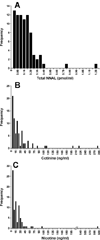Metabolites of a tobacco-specific lung carcinogen in children exposed to secondhand or thirdhand tobacco smoke in their homes
- PMID: 21467230
- PMCID: PMC3111852
- DOI: 10.1158/1055-9965.EPI-10-1027
Metabolites of a tobacco-specific lung carcinogen in children exposed to secondhand or thirdhand tobacco smoke in their homes
Abstract
Background: People exposed to secondhand tobacco smoke (SHS) inhale the lung carcinogen 4-(methylnitrosamino)-1-(3-pyridyl)-1-butanone (NNK) which is metabolized to NNAL and its glucuroniders. These urinary metabolites, termed total NNAL, can be quantified. A related compound, iso-NNAL, has been proposed as a biomarker for exposure to smoke constituent residues on surfaces (thirdhand tobacco smoke). There is limited information in the literature on levels of total NNAL in children exposed to SHS.
Methods: We recruited 79 parent--child dyads from homes where the enrolled parent was a cigarette smoker and visited their homes. Parents were asked questions, home ambient air quality was evaluated, and children provided urine samples. Urine was analyzed for total NNAL, total cotinine, total nicotine, and iso-NNAL.
Results: Ninety percent of the children had detectable total NNAL in urine; total nicotine and total cotinine were also detected in most samples. There were significant positive relationships between biomarker levels and exposure of children in the home. Levels were highest in homes with no smoking restrictions. African American children had significantly higher levels than other children. iso-NNAL was not detected in any urine sample.
Conclusions: There was nearly universal exposure of children to the lung carcinogen NNK, due mainly to exposure to SHS from adult smokers in their homes.
Impact: Homes with adult smokers should adopt restrictions to protect their children from exposure to a potent lung carcinogen.
©2011 AACR.
Figures




References
-
- U.S.Department of Health and Human Services. Washington, DC: U.S.: Dept. of Health and Human Services, Centers for Disease Control and Prevention, National Center for Chronic Disease Prevention and Health Promotion, Office on Smoking and Health; 2006. The Health Consequences of Involuntary Exposure to Tobacco Smoke: A Report of the Surgeon General. - PubMed
-
- Hecht SS. Human urinary carcinogen metabolites: biomarkers for investigating tobacco and cancer. Carcinogenesis. 2002;23:907–922. - PubMed
Publication types
MeSH terms
Substances
Grants and funding
LinkOut - more resources
Full Text Sources
Medical

